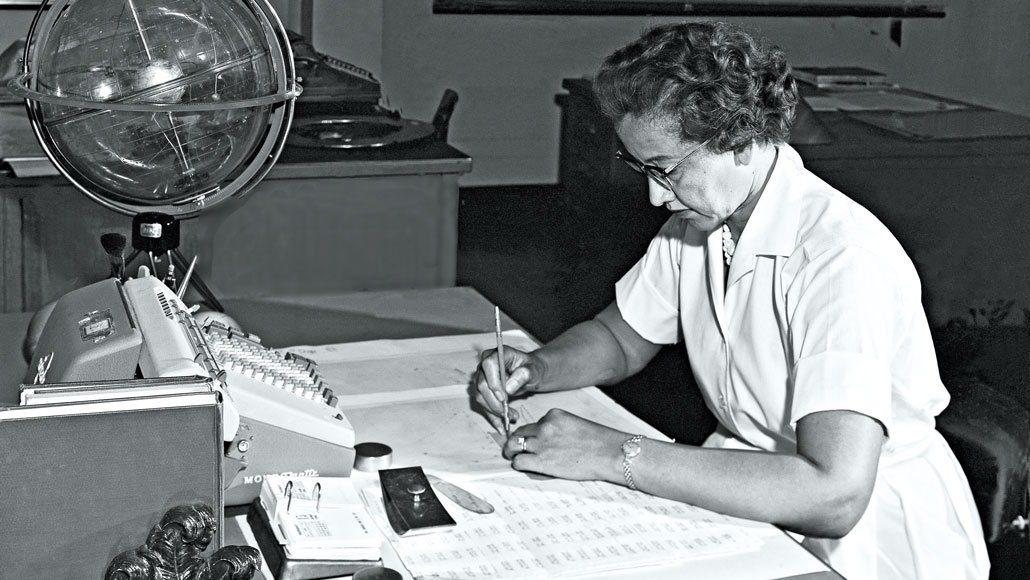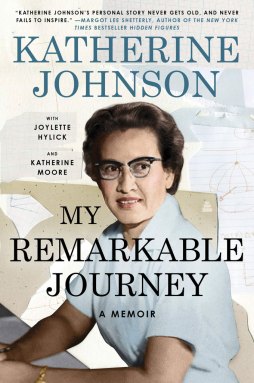A new memoir tells the life story of NASA ‘hidden figure’ Katherine Johnson
‘My Remarkable Journey’ offers a window into U.S. race relations during the 20th century

Mathematician Katherine Johnson is show working at NASA’s Langley Research Center in Hampton, Va., in 1962.
Bob Nye/NASA
- More than 2 years ago
My Remarkable Journey
Katherine Johnson with Joylette Hylick and Katherine Moore
Amistad, $25.99
Katherine Johnson became a household name circa 2016, when the bestselling book and Hollywood film Hidden Figures highlighted her role as a NASA mathematician during the space race (SN: 1/21/17, p. 28). Those works showcased Johnson’s ability to perform high-stakes calculations to send astronauts to space, all while she endured racism and sexism from her colleagues. But crunching numbers for NASA is only part of Johnson’s story. Her posthumous memoir, My Remarkable Journey, tells the rest (SN: 2/24/20).
Cowritten with two of her three daughters, Johnson’s memoir spends surprisingly little time explaining her work at NASA. Instead, the book focuses on Johnson’s personal life, including many experiences that reveal insight into the United States’ tumultuous race relations in the 20th century.
Her account begins with her childhood in small-town West Virginia. Even then, Johnson’s thirst for knowledge was palpable: She snuck out to follow her older siblings to school, peppered her parents and teachers with questions, and counted everything in sight. While in college at West Virginia State University, Johnson decided she wanted to become a mathematician.
Readers quickly see the profound obstacles that faced educated Black people like Johnson. When she graduated in 1937 at age 18 with the highest GPA in her university’s history, Johnson had few employment opportunities. Her only job offer was a teaching gig at an all-Black elementary school.
Johnson uses her own educational and work experiences as windows into broader issues. She frequently pivots from her story to describe her teachers’ race-based struggles and the history of the Black schools she attended or served. These asides slow the narrative but reveal something deeper: Johnson’s immense pride in Black educational institutions and her gratitude to the Black educators who were her role models.
Later chapters continue zooming out from Johnson’s own experiences to historic events. She describes her concerns about allowing her daughters to participate in school integration. “Once I’d seen what those Negro teenagers experienced in Little Rock, I couldn’t unsee it,” she writes of the white mob violence faced by Black students integrating into a white school in Arkansas. She also advised her daughters not to participate in civil rights protests because she was afraid of them getting hurt or arrested. (They protested anyway.)
At times, however, Johnson’s historical asides seem purely expositional. Readers may wish that the memoir directly offered Johnson’s unique perspective on some issues. For instance, she describes a protest led by Rev. Ralph Abernathy — Martin Luther King Jr.’s successor as president of the Southern Christian Leadership Conference — in objection to the taxpayer dollars spent on the space race rather than poverty relief. But Johnson doesn’t share her own reactions to this event.
It’s also clear that Johnson isn’t comfortable bragging about herself. She touts the careers of other accomplished Black scientists and astronauts, but of her own work, she writes, “I was just doing [my] job.” That might seem like false modesty, but it rings true coming from a woman who didn’t invite her own daughters to her retirement luncheon at NASA because, as she writes in the book, she “didn’t want to make a big fuss.”
Perhaps more striking than Johnson’s unwavering humility is how she faced segregation and discrimination with her head held high. When she moved to the South for her first job, her mother warned her about the racism she would face: “Remember, you’re going to Virginia.” But Johnson just said, “Well, tell them I’m coming!” And when a white friend told Johnson that his pastor forbade Black guests at his wedding, “I just shrugged it off,” she writes. “I was not going to allow his pastor’s backward views to change my opinion of the lovely couple.”
These examples of relentless determination in the face of adversity linger with the reader, showing what truly makes Johnson’s journey remarkable. Yes, her mathematical genius was inspiring. Equally inspiring was her grit.
Buy My Remarkable Journey from Bookshop.org. Science News is a Bookshop.org affiliate and will earn a commission on purchases made from links in this article.








